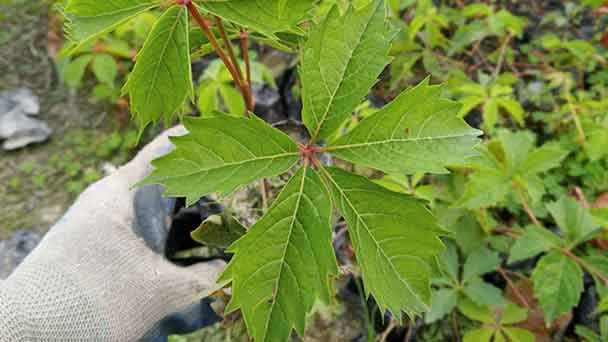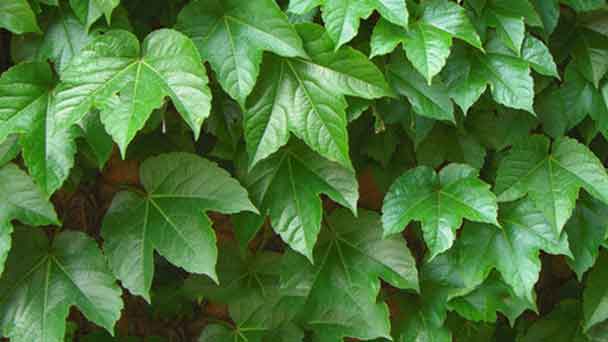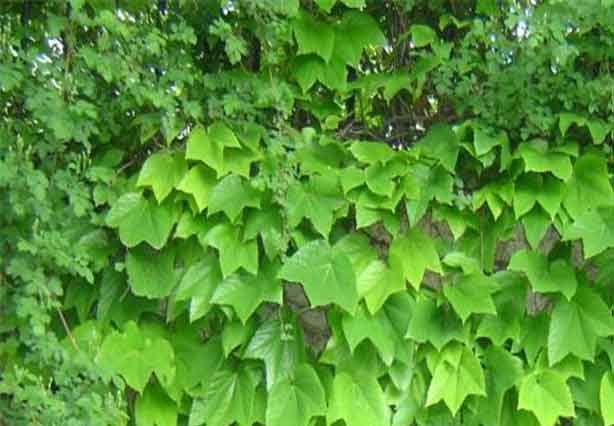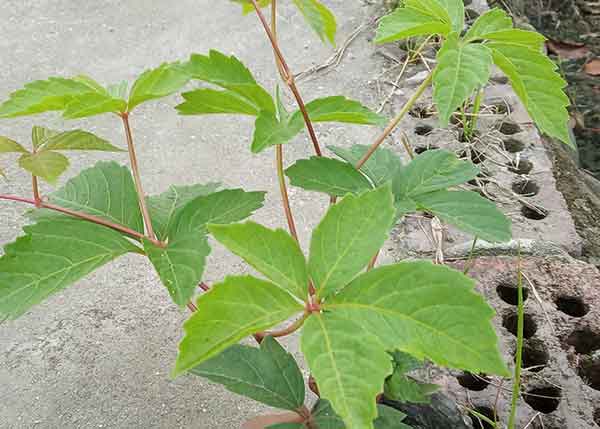Virginia Creeper Vine: Grow & Care for Parthenocissus quinquefolia
Written by Iris
Aug 13 2021

The Virginia creeper (Parthenocissus quinquefolia) is a perennial woody vine that can climb on other objects or ground paths. The Virginia creeper is a common weed in orchards, vineyards, and blueberry plantations. The Virginia creeper can grow in a variety of conditions, including dry sandy or wet organic soils, sunny or cool places, and can tolerate high salinity.

Snap off a section of the growing tip of Virginia creeper in late spring or summer. Choose a section that is several inches long with the newest leaves smaller than the older ones and the woody vine just beginning to harden. Alternatively, cut off an end section of older, harder, more woody vine that contains several leaf nodes in the winter when the Virginia creeper is dormant. Do not use sections of the vine that have flowers and use only healthy parent stock. Keep the cutting moist until time to plant it.
Pinch off the leaves from the lower half of the cutting. Dip the cut end of the cutting in rooting hormone powder, if desired.
Stick the cutting upright into the prepared rooting medium with the cut end down. Push it into the medium to about half its length. If you are rooting more than one cutting, place them far enough apart so their leaves do not overshadow one another.
Transplant the cutting into a flowerpot filled with moist, sterile potting soil in a few weeks when it has roots an inch or so long. Continue to keep the Virginia creeper in a bright location and keep the soil moist. After a few weeks, when the plant is stable in the pot, transplant it outdoors, soil and all, to the desired location.
April – Oct this Maple should be irrigated 2 x weekly.
Nov – Mar this Maple should be irrigated 2 x monthly
‘Engelmanii’: This variety has small, attractive leaves and clings to walls and fences better than other varieties.
‘Monham’: Like some varieties of ivy, this cultivar has leaves with white variegations.
‘Variegata’: This plant doesn't grow as vigorously as other varieties, but its leaves are variegated with yellow and white. In the fall, these variegations become pink and red.
How to Choose and Prepare a Planting SiteWhen to Grow Virginia Creeper (Parthenocissus quinquefolia)How to Grow Virginia Creeper (Parthenocissus quinquefolia)How to Care for Virginia Creeper (Parthenocissus quinquefolia)Varieties of Virginia Creeper (Parthenocissus quinquefolia)Virginia Creeper (Parthenocissus quinquefolia) FAQ
How to Choose and Prepare a Planting Site
Virginia creeper is suitable for large gardens only. Grow it against a wall of a house, where it has room to spread without becoming a problem. Less rampant varieties such as Chinese Virginia creeper, Parthenocissus henryana, can be grown against a garden wall or fence.When to Grow Virginia Creeper (Parthenocissus quinquefolia)
Plant Virginia creeper in spring or autumn, so it can establish well while the soil is moist and warm.
How to Grow Virginia Creeper (Parthenocissus quinquefolia)
Steps for Virginia Creeper (Parthenocissus quinquefolia) Propagation with Cuttings
Prepare a rooting medium of coarse sand, or use a combination of half sand and half peat or half peat and half perlite. Work in enough water so the medium is moist but not soggy. Pour the moistened medium in a container several inches deep and level the surface.Snap off a section of the growing tip of Virginia creeper in late spring or summer. Choose a section that is several inches long with the newest leaves smaller than the older ones and the woody vine just beginning to harden. Alternatively, cut off an end section of older, harder, more woody vine that contains several leaf nodes in the winter when the Virginia creeper is dormant. Do not use sections of the vine that have flowers and use only healthy parent stock. Keep the cutting moist until time to plant it.
Pinch off the leaves from the lower half of the cutting. Dip the cut end of the cutting in rooting hormone powder, if desired.
Stick the cutting upright into the prepared rooting medium with the cut end down. Push it into the medium to about half its length. If you are rooting more than one cutting, place them far enough apart so their leaves do not overshadow one another.
Transplant the cutting into a flowerpot filled with moist, sterile potting soil in a few weeks when it has roots an inch or so long. Continue to keep the Virginia creeper in a bright location and keep the soil moist. After a few weeks, when the plant is stable in the pot, transplant it outdoors, soil and all, to the desired location.

How to Care for Virginia Creeper (Parthenocissus quinquefolia)
Light
The Virginia climber thrives when planted in areas with full sun to partial shade. It can also survive under a canopy with blotchy sunlight. During flowering and fruit-bearing stages, it is better to give the plant at least 6 hours uninterrupted exposure to sunlight for continuous growth and development.Soil
Grow Virginia creeper in well-drained soil. It will grow well in a variety of soil types, including clay, sand, or loam. It will tolerate a range of soil acidity and alkalinity.Water
Water newly planted trees regularly with a garden hose for at least one month (2 months in Summer). Automatic irrigation systems may not be sufficient initially. Water frequency will vary according to the season, exposure, and plant size.April – Oct this Maple should be irrigated 2 x weekly.
Nov – Mar this Maple should be irrigated 2 x monthly
Temperature and Humidity
Parthenocissus quinquefolia is indigenous to eastern North America and can be grown in USDA plant hardiness zones 3 to 9. The plant should survive down to temperatures of -10 degrees Fahrenheit when dormant in winter. It can be damaged by a late frost after spring growth has started.Fertilizer
Application of fertilizer should be done as needed, depending on the soil fertility status. During its flowering stage, it is better to avoid the application of nitrogen fertilizers as it will encourage leaf formation and may hinder flower formation.Pruning
Prune Virginia creeper back during the growing season if it becomes unruly and dig up any plants that spread. Keep Virginia creeper off trees and shrubs. It will slowly choke other plants and blocks off light. Virginia creeper attaches itself to masonry and walls with adhesive disks. It is difficult to remove and should be considered a permanent planting.
Varieties of Virginia Creeper (Parthenocissus quinquefolia)
Although common Virginia creeper grows well in most yards, you might try several improved horticultural varieties for increased pest resistance. Below are a few to consider:‘Engelmanii’: This variety has small, attractive leaves and clings to walls and fences better than other varieties.
‘Monham’: Like some varieties of ivy, this cultivar has leaves with white variegations.
‘Variegata’: This plant doesn't grow as vigorously as other varieties, but its leaves are variegated with yellow and white. In the fall, these variegations become pink and red.
Virginia Creeper (Parthenocissus quinquefolia) FAQ
Why is Virginia creeper sometimes a nuisance?
The berries are highly toxic and may be fatal to humans. The sap contains oxalate acid that may be irritating to the skin. When it grows where it is not wanted, it can cause problems. As it grows upon any tree or shrub it covers the top with dense foliage that prevents the host plant from receiving sunlight which eventually chokes and kills the plant. It will also “travel” from plant to plant or tree if they are close enough.Is Virginia Creeper poisonous?
It is not completely poisonous but the berries and leaves can cause mouth, lips, tongue, and throat irritations when ingested. Other symptoms such as nausea, drowsiness, vomiting, and other intestinal problems may occur and could last up to half a day.Is Virginia Creeper invasive?
Rather than being invasive, the P. quinquefolia is labeled as aggressive due to its vast growth and development.Is Virginia Creeper fast-growing?
The Virginia Creeper is labeled as aggressive and grows rapidly due to its ability to self-layer and the possibility of reproduction through seeds and soft-wood cuttings.
Latest Updated
- Benefits of Bugleweed - 7 Science-backed Health Benefits
- Bugleweed Dangers & Side Effects - Is It Poisonous?
- How to Plant Evergreen Trees - What You Should Know
- When to Plant Evergreens - Grow Guide for Evergreen Trees
- 12 Wonderful Evergreen Shrubs for Your Garden
- 12 Popular Evergreen Plants with Pictures for Beginners
- When And How To Prune A Lilac Bush Like a Pro
- How to Grow & Care for Lilac Vine (Hardenbergia Violacea)
- Japanese Lilac Tree (Syringa Reticulata) Care & Propagation Guide
- Shumard Oak Pros and Cons - What to Know
Popular Articles
- Winter maintenance of Antirrhinum Majus
- How to Grow Terminalia Mantaly Tree
- How to Grow and Care for Crossostephium Chinense
- How to grow Antirrhinum Majus in spring
- Peristeria Elata (Dove Orchid) Profile: Info & Care Guide
- Underwatered Snake Plant (Sansevieria Trifasciata) - Signs And How To Fix
- How to Care for Brazilian Jasmine Plant (Mandevilla Sanderi)
- How to Grow & Care for Graptopetalum Purple Delight in Summer
- Rosa Chinensis (China Rose): Plant Growing & Care Tips
- How to Care for Baby Sun Rose (Aptenia Cordifolia)